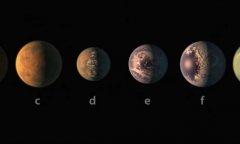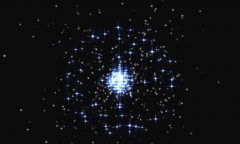By Vishal Goel, | February 24, 2017

An artist's illustration of Mars with rings.
According to an analysis of data from a Mars-orbiting satellite, Mars is building Saturn-like rings from interplanetary dust and fragments from its disfigured moons, Phobos and Deimos. Researchers say that the ring formation could take a few million years owing to the two moons being gradually chipped away as they are drawn closer to the red planet by its gravity.
Like Us on Facebook
Astronomers have long thought that it was possible for Mars to develop rings from bits of rock kicked up from its moons Phobos and Deimos, but no one had ever observed them, probably because the rings lie in planes not easily viewed from Earth or space telescopes - or perhaps they were not there at all, reports New Scientist.
However, in 2013, the Mars Atmosphere and Volatile Evolution (MAVEN) satellite spotted a cloud of high-altitude dust surrounding the planet when it arrived on Mars. The MAVEN team could not determine the size of the dust particles or their source, but they observed that they were spread out uniformly rather than being concentrated into rings. That suggested they were coming from interplanetary space. A fresh analysis of the MAVEN data also suggests that Mars is surrounded by dust in the form of proto-rings, and some of it is coming from its moons.
Jayesh Pabari, at Physical Research Laboratory in Ahmedabad, India, and his colleagues have compared the MAVEN dust measurements with models based on existing assumptions about meteoroids that have hit Mars and its moons.
They claim that smaller particles thrown up by the meteoroid strikes are usually swept away by the solar wind, while the gravity on Mars collects the larger particles into proto-rings located along each moon's orbit. According to Pabari's team, while the most of the dust cloud is interplanetary, about 0.6 per cent of it could be coming from Phobos and Deimos. "The bigger ring particles can reach Mars over a period of time, in addition to the interplanetary dust particles," Pabari writes.
The MAVEN team is not convinced of existence of any proto-rings. As for the dust cloud around Mars, it is hard to be sure of its origin since MAVEN was not designed to look for dust. Hence, Pabari is proposing a future dust investigation mission called the Mars Orbit Dust Experiment (MODEX).
-
Use of Coronavirus Pandemic Drones Raises Privacy Concerns: Drones Spread Fear, Local Officials Say

-
Coronavirus Hampers The Delivery Of Lockheed Martin F-35 Stealth Fighters For 2020

-
Instagram Speeds Up Plans to Add Account Memorialization Feature Due to COVID-19 Deaths

-
NASA: Perseverance Plans to Bring 'Mars Rock' to Earth in 2031

-
600 Dead And 3,000 In The Hospital as Iranians Believed Drinking High-Concentrations of Alcohol Can Cure The Coronavirus

-
600 Dead And 3,000 In The Hospital as Iranians Believed Drinking High-Concentrations of Alcohol Can Cure The Coronavirus

-
COVID-19: Doctors, Nurses Use Virtual Reality to Learn New Skills in Treating Coronavirus Patients











